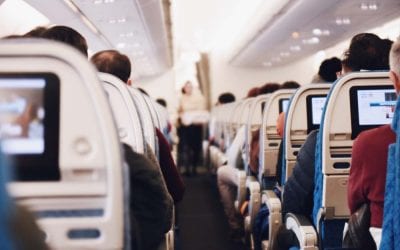Rarely will readers see me support consolidation in the airline industry. But, this time the Alaska-Virgin merger will link up two customer-friendly airlines with progressive ideas about customer service. This merger will allow Alaska to improve its network and to better fend off attacks from Delta Air Lines at its Seattle hub. However, the antitrust establishment has work to do yet.
The good news:
- Loss of competition barely registers with this Alaska-Virgin merger. It is a merger of a transcontinental carrier with a West Coast carrier. These two airlines have almost no overlapping routes.
- Both airlines are customer focused.
- Of course, there are saving synergies. (In this merger, they may be real.)
- This is the first merger in memory between two healthy carriers. Neither airline is going through bankruptcy.
The bad news:
- Mixing a fleet of Boeing (Alaska) and Airbus (Virgin) may pose a problem, but not in the near term, as both airlines are expected to operate independently in terms of operations. Alaska Air operates a fleet of 147 Boeing 737 aircraft while Virgin America boasts a fleet of 60 Airbus A319 and A320 aircraft.
- Blending two large airlines is always a balancing act between operations, equipment, technology and labor. It will be difficult.
As the largest airlines in America merged together they began to squeeze out the smaller airlines. This was made possible by a combination of their domestic network, their international footprint, antitrust immunity, check-in desks and aggregated gates, plus takeoff and landing slots at the country’s most important airports. The lack of Department of Transportation (DOT) rules requiring full disclosure of ancillary fees and the proliferation of antitrust immunity grants damaged the free market operations and harmed consumers. (More on that later.)
The “Big 3” network airlines over the past two years have been focused on their own profits at the expense of the flying public. Meanwhile, a group of smaller airlines elected to focus more on customer service. Two of those are Alaska Airlines and Virgin America. Both are known for excellent customer service (Virgin) and innovations in operations (Alaska) that have been keeping customers happy. Alaska gets the fewest complaints and Virgin America wins the top airline awards.
One way to look at the Alaska-Virgin merger is by examining how miserable this newly merged airline will make life for American, Delta and United. The more market pressure other airlines can put on the Big 3, the more the Big 3 will be forced to change and become more customer friendly.
The biggest loser with this Alaska-Virgin merger is Delta Airlines. Delta has been throwing its weight around in Seattle trying to dislodge Alaska Airlines as that city’s favorite airline. So far, Alaska has been defying the odds and holding their own against the Delta onslaught. The new larger airline will have a beefed-up transcontinental presence that will allow them to put more pressure on Delta. Plus, the Alaska frequent flier program will favor American Airlines, which will pressure Delta even more.
United will find itself facing more competition in San Francisco. Although United Airlines will still have 45 percent of the market share, the Alaska-Virgin market share will grow to 15 percent. This should make the SFO to East Coast routes far more competitive, especially as the benefits of the Alaska-Virgin frequent flier programs kick in with its links to American Airlines.
The big Alaska-Virgin merger winner among the Big 3 is American Airlines. American and Alaska Airlines have entered into an extensive partnership. The larger San Francisco hub for Alaska is one factor. The doubling of Alaska Airline’s presence in Los Angeles, where American is growing their international gateway to Asia, is another. This deal will give American a bonanza of connecting flights with which to keep their Asia/Pacific network fed.
This Alaska-Virgin merger also demands fundamental change of the aviation marketplace by DOT
As part of this merger, the Department of Transportation should make competition more competitive.
- Allow full price comparisons — DOT should mandate that airfares together with all ancillary fees must be disclosed and available through all airline ticket sales outlets.
- Forbid airlines from restricting the publication of their prices. Airfares and fees should be public so that consumers can comparison shop.
- Enforce the Open Skies Treaties. This will provide additional competition in the international arena. (Norwegian Air International should be approved for transatlantic flights and the Middle Eastern airlines operations should not be restricted.)
- Review antitrust immunity grants implemented between US carriers and their alliance partners. These alliances have resulted in defacto merged airlines that are restricting competition and hoarding gates, as well as takeoff and landing slots.
- Realign takeoff and landing slots at slot-controlled airports in the New York area (LaGuardia and JFK airports). Because of past mergers, these airports have become captive by only two or three airlines. And, other airlines have no opportunity to effectively compete in America’s biggest market.
Overall antitrust protection is not only in the hands of the Department of Justice. It also resides with DOT when it comes to antitrust immunity protections and maintenance of a free marketplace for aviation. Plus, the FAA factors in as it decides how much concentration of airline power is allowed at the nation’s largest and busiest airports. All three executive departments are a part of the American public’s antitrust protection.
Without an overall plan and coordination among the three aviation antitrust facets of the government, a consumer-friendly merger between Alaska Airlines and Virgin America will be doomed by the enormity of America’s network carriers and the power of their unrestrained alliances.

Charlie Leocha is the President of Travelers United. He has been working in Washington, DC, for the past 14 years with Congress, the Department of Transportation, and industry stakeholders on travel issues. He was the first consumer representative to the Advisory Committee for Aviation Consumer Protections appointed by the Secretary of Transportation from 2012 through 2018.



